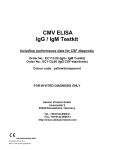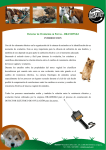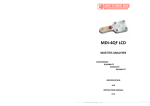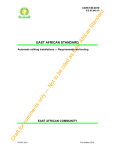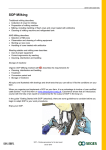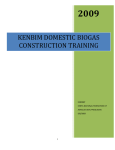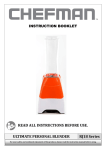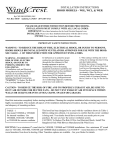Download Instruction Manual
Transcript
CONTENTS 1. INTRODUCTION……………………………………………………………………… 3 2. CONSTRUCTION…...………………………………………………………………… 4 3. OPERATION…………………………………………………………………………… 7 4. MEASUREMENTS…………………………………………………………………….10 5. INTERPRETATION OF RESULTS…………………………………………………. 14 6. BATTERY REPLACEMENT…………………………………………………………. 15 7. TECHNICAL DATA…………………………………………………………………… 16 8. END NOTES…………………………………………………………………………… 16 1 2 CONSTRUCTION ELECTRONIC DETECTOR OF SUBCLINICAL MASTITIS IN COWS: Currently, there are three models of Mastitis detectors are available: • • • Enables the rapid detection of subclinical mastitis in a large number of cows, directly in the cowhouse just before milking. It allows appropriate preventive steps to be made that could prevent the disease from its transition into a clinical condition. Has a mobilising effect on breeders and the personnel taking care of animals. Improves the economic results of stock farming. SYSTEMATIC UDDER EXAMINATION IS AN IMPROTANT ELEMENT OF PREVENTION. Preventing is cheaper than treating INTRODUCTION Mastitis - inflammation of the udder - is one of the most important and costly problems in dairy farming. Subclinical states of mastitis are particularly dangerous. In this state, milk looks normal and the udder or quarter affected appears healthy. Subclinical mastitis can rapidly become clinical mastitis or can continue at subclinical levels, affecting milk production, milk quality, and spreading infection to other cows in the herd. Research carried out over many years has established that the development of subclinical mastitis is accompanied by a rise in the level of salt in the milk, which immediately lowers its electrical resistance. Since the discovery of this relationship, electronic methods of detecting subclinical mastitis have become widely accepted and practical. It seems that only one cow is affected (Fig. 1). However, in reality, the situation is different (Fig. 2). 20-100% of cows in a herd may be sick. Undiagnosed subclinical conditions are a cause of the most severe loss sustained by milk producers. MASTITIS is a world-wide problem… … therefore the ELECTRONIC DETECTOR OF SUBCLINICAL MASTITIS is successfully used by farmers all over the whole world. healthy cows ill cows – clinical mastitis, symptoms are clearly visible 1. Model : 4x4 Q MAST The device consists of a 4 measurement vessel (cups) with electrodes, electronic unit with LCD panel, handle containing a standard 9 volt battery marked as: 6F22, 6LR61, or 1604E and a switch. Application of a special display showing results taken from all 4 quarters makes work more effective. a measuring vessel (cup) with two metal electrodes LCD screen displaysthe results of all four quarters On/Off button ill cows – subclinical mastitis, symptoms are invisible a handle with a 9V battery Research carried out over many years has established that the development of subclinical mastitis is accompanied by a rise in the level of salt in the milk, which immediately lowers its electrical resistance. Since the discovery of this relationship, electronic methods of detecting subclinical mastitis have become widely accepted and practical. The relationship of milk electrical resistance and health of the udder resulted in the development of the DRAMIŃSKI MASTITIS DETECTOR by Mr. J. Dramiński in 1989 with the co-operation of Polishagricultural universities. 3 4 2. Model: 4Q MAST The device consists of a one measurement vessel (cup) with electrodes, electronic unit with LCD panel, handle containing a standard 9 volt battery marked as: 6F22 and a switch. Application of a special display showing results taken from all 4 quarters makes work more effective. 3. Model: 1Q MAST The device consists of a one measurement vessel (cup) with electrodes, electronic unit with LCD panel, handle containing a standard 9 volt battery marked as: 6F22 and a switch. Application of a special display showing results taken from single quarters a measuring vessel (cup) with two metal electrodes LCD screen displays the results of the one quarter a measuring vessel (cup) with two metal electrodes LCD screen displays the results of all four quarters On/Off Switch a handle housing a 9V battery On/Off Button a handle with a 9V battery The device housing is drop-proof what makes its use more safe and cleaning easier. The instrument is made of polypropylene, resistant to atmospheric conditions, most chemicals, shock, breakage, and not easily wet by milk. It is sealed and waterproof, for easy washing and cleaning. 5 6 OPERATION 2. Model: 4Q MAST 1. Model: 4x4Q MAST The display indicates the proper work of the device. The first check-out of the detector should be conducted with no milk in the cup, in the ‘empty air’, when electrodes are spaced. After pressing the button four column of dashes are displayed indicating the device readiness to work. . --- ----- --- (---) ----- --- NOTE! The device switches off after 30 seconds of idle operation – for battery saving purposes. After pouring milk into all four cups, press the “on” button, the device will count down 3 seconds 3 3 3 3 2 2 The display indicates the proper work of the device. The first checkout of the detector should be conducted with no milk in the cup, in the ‘empty air’, when electrodes are spaced. After pressing the button four column of dashes are displayed indicating the device readiness to work. Now the consecutive milk quarters can be measured. Blinking dashes indicate the column where the results from specific milk quarter will be shown. To take a measurement the milk is to be poured in and the switch pressed. 2 2 1 1 1 1 Note! The device switches off after 30 seconds of idle operation – for battery saving purposes. After the switch is pressed, the flashing dashes disappear, and result will come up in specific numbers. Next, the flashing dashes will appear in the next column. Similarly all other measurements from the next quarters will be done. 370 (---) --- --- And the screen displays the results of all four quarters, for example: Additionally, the display indicates a low battery level. When the battery icon flashes, it indicates that it is necessary to replace it. 370 380 380 380 Additionally, the display indicates the exhaust state of the battery. A flashing battery symbol signals that the battery is to be replaced. Technical data indicate that the lowest result is 10 units, and the measurement range is between 10 and 990 units. Beyond those limiting values the display shows dashes (the same symbol as for a “dry” measurement). The measurement range of the device significantly exceeds the maximum resistance of the milk tested. Therefore, in practice, it is never reached. 10 units is the lowest result possible whereas the measurement range is 10-990 units. After the level of 990 units has been exceeded dashes are shown on the display (the same symbol as in the case when the device tried in the ‘empty air’. 7 8 3. Model: 1Q MAST MEASUREMENTS The display indicates the proper work of the device. The first checkout of the detector should be conducted with no milk in the cup, in the ‘empty air’, when electrodes are spaced. After pressing the button two dashes are displayed indicating the device readiness to work. After the switch is pressed again the display shows the value "1 0". Number '1' stands for no contact of the electrodes, and number '0' indicates that no measurement has been made, except for automatic verification of operation. 1 0 When the device displays two dashes (readiness for measurement), the cup should be filled with milk and the switch should be pressed to read the result. 350 Before starting your measurement the following should be done: 1. Check the work of the detector in the ‘open air’ ensuring that the battery is fully charged. 2. Ensure that the electrodes in the cups are clean. Contamination of electrodes with skin-oil from handling or examination while on display in stores and/or dried milk-fat can result in incorrect (high) readings. If required, wipe the electrodes with methylated spirits on a clean cloth or tissue, or similarly with kitchen detergent and rinse off. a) prepare a solution – pour a pinch of salt into a glass of water (of room temperature) dissolving it completely. b) fill out the cups with the solution and read the result (it depends on the solution concentration. c) Pour out the solution into the glass and clean thoroughly the electrodes with a tampon moisten with the liquid for washing the dishes. Rinse the cups under the tap shaking the water remaining off. d) pour the solution into the cups again and read the result. If there is a remarkable drop in the result in comparison to the previous measurement it means the electrodes were coated with fat. e) the best is to repeat cleaning procedures until it is sure that the results do not change any more. The latter means the electrodes are now clean. Note that even touching the electrode with a finger may contaminate the electrodes. 3. Prepare a bucket full of warm water for rinsing the cup after each measurement. Additionally, another empty bucket will be useful for pouring out the milk from the cup after the measurement. To comply with the hygienic regulations you must not pour the milk out on the cowshed bedding. Additionally the display indicates a low battery level. A flashing “LO BAT” symbol indicates that it is necessary to replace the battery. LO BAT ALLWAYS THE FIRST SQUIRTS OF MILK SHOULD BE MEASURED that are squirted directly to the measurement cup. Each quarter should be examined separately. Technical data indicate that the lowest result is 10 units and the measurement range is between 10 and 1990 units. Beyond those limiting values the display shows "1 0" (the same as for a “dry” trial measurement). The measurement range of the device significantly exceeds the maximum resistance of the milk tested. Therefore, in practice, it is never reached. NOTE ! The MASTITIS DETECTOR (all models) is not intended for the measurement of pooled milk. The device should be used only for measuring milk collected directly from udders. 9 10 Measurements are made in the following way: 8. The detector is automatically switched off after 30 seconds of idle operation following the last pressing of the switch. The device may be also switched off by pressing and holding the switch for more than 3 seconds. Model: 4x4Q MAST 1. Place the cups under teats A, B, C, D and squirt the first streams of milk to fill the cups (minimum volume – approx. 1 cm from the top edge of the cup). Milk should be squirt as fast as possible. 2. Then press the on/off switch. The device will count down three seconds 3 3 3 3 2 2 2 2 1 1 1 1 Model: 4Q MAST 1. Switch the device on, place the measuring cup under teat A and squirt the first stream of milk into the measuring cup to fill it up (minimum volume is approx. 1 cm from the top edge). 2. Wait for a second and press the on/off switch – a result will be displayed. For example: 370 (---) --- --- 3. Results for each quarter will be displayed, for example: 370 380 380 380 3. Discard the milk to the last drop and press the switch again – dashes will flash in the next column of the display. 4. Repeat the same procedure for teats B, C and D, to obtain readouts for the four quarters, for example: 4. For easier detection of the quarter in danger of the disease it is possible to press the switch again to display the differences between the individual quarters, in relation to the highest result obtained, for example: 10 0 0 0 370 380 320 380 5. . After reading the results and differences for individual quarters, they should be interpreted according to the principles presented in the following section. 10 60 5. Pour the milk into the prepared bucket (to the last drop). In the case of a milk yield hall, the milk may be discarded into the catch basin. 6. After a cow has been tested, the device should be rinsed: cups should be immersed in water and vigorously moved to remove any residues of milk. 7. Another cow may be tested immediately after rinsing the measuring cups and a short press of the switch. All the results will be erased and readiness for another test will be displayed. 11 For easier detection of the quarter in danger of the disease it is possible to press the switch again to display the differences between the individual quarters, in relation to the highest result obtained, for example: 0 0 After reading the results and differences for the individual quarters, they should be interpreted according to the principles presented in the following section. 6. After a cow has been tested, the device should be rinsed: the cup should be immersed in water and vigorously moved to remove any residues of milk. 12 Note ! Rinsing should also be completed after testing a quarter in which a subclinical condition has been detected. That way, residues of milk from that sample will not affect the measurement of another quarter. INTERPRETATION OF RESULTS IT IS NECESSARY TO EVALUATE RESULTS ACCORDING TO TWO CRITERIA: 1. What is the value obtained from the tests of quarters and is it typical for the 7. Another cow may be tested immediately after rinsing the measuring cup and a short pressing of the switch. All the results will be erased and readiness for another test will be displayed. 8. The device may be switched off by pressing and holding the switch for more than 3 seconds. The detector automatically switches itself off after 30 seconds of idle operation following the last pressing of the switch. Model: 1Q MAST 1. 2. 3. 4. 5. Press the on/off switch to display readiness for measurement (two dashes). Place the measuring cup under teat A and collect the first stream of milk into the measuring cup to fill it up (minimum volume is approx. 1 cm from the top edge).. Press the switch again and read the result Repeat the same procedure for teats B, C and D. After a cow has been tested, the device should be rinsed: the cup should be immersed in water and vigorously moved to remove any residues of milk. Note! Rinsing should also be completed after testing a quarter in which a subclinical condition has been detected. That way, residues of milk from that sample will not affect the measurement of another quarter. After a cow has been tested it is recommended to note the principle conclusion or mark it with a symbol. Is the udder completely healthy, or is there a suspicion of the disease. SYSTEMATIC UDDER EXAMINATION IS AN IMPROTANT ELEMENT OF PREVENTION. Preventing is cheaper than treating tested cow (individual evaluation considering the age of a cow), 2. What are the differences between the quarters in a tested cow. Regarding item 1: Readings below 250 units: Indicate clear subclinical inflammation of a quarter of an udder, or high risk of transition into an acute condition (which may be rapid). Readings over 300 units: good condition of a quarter of an udder. Usually results fall within the range of 330-360 units. In young and healthy cows results may be higher (370-400), and in older cows they may be lower (300-320). Readings from 250 to 300 units: a transitional state between subclinical mastitis and a normal condition. Due to physiological differences it is difficult to define a strict border value, the exceeding of which indicates the disease of a quarter of an udder. In some cows a readout between 250 and 300 units is considered normal, especially if no higher values are obtained from that individual cow. In that case a quarter should be considered normal. However, if in a cow for which normal values exceeded 300 units a sudden drop is observed to the level of 250 - 300 units, the cow should be considered at risk of mastitis. Regarding item 2: A difference exceeding 40 - 50 units between the highest and the lowest result obtained for quarters in a tested cow indicates the onset of subclinical mastitis. It is necessary to examine the cow systematically before each milk yield, and observe it for the progression of the disease (a further drop of results for the suspected quarter). Moreover, particular care and increased hygiene before and after milk yield are necessary. SAMPLE INTERPRETATIONS: a young cow, 2nd lactation, readouts over 300 units were obtained for all quarters, but a difference suggests that the quarter C may be subclinically inflamed. Further tests of that cow are necessary. quarter A = 370 quarter B = 380 quarter C = 310 a difference of 70 units compared to the maximum result (quarter B) quarter D = 370 a middle-aged cow, 5th lactation, results indicate that one quarter (D) is at risk of inflammation, therapy should be started and the cow should be further observed 13 14 quarter A = 340 quarter B = 350 quarter C = 350 quarter D = 260 TECHNICAL DATA Weight a result below 300 units and a difference of 90 units compared to the highest result (quarters B and C) an old cow, 9th lactation, for one quarter (B) the readout is below 300 units, but it is rather common in cows at that age – all is physiologically normal. quarter A = 310 quarter B = 290 a result below 300, but the maximum difference is only 20 units. quarter C = 300 quarter D = 300 Important factors affecting the level of results obtained from the tests of healthy cows: 1. animal’s age, 2. breed (the above interpretation is valid for black and white + hf cows; Jersey cows would have readouts at a higher level), 3. individual properties of animals (e.g. fat content in milk), 4. nutrition – composition of a dose or its alteration may influence results, 5. physiological condition (e.g. tests should be discontinued during heat period), 6. metabolic abnormalities (acidosis or alkalosis) may be diagnosed based on a surprising significant increase or decrease of results for all cows in a herd. Note! Only the systematic control of cows allows the proper and effective use of the detector. The detector may not be used for the testing of quarters clearly inflamed and with significant changes in milk. In those cases the correct interpretation of results is impossible. The method of the measurement of changes in milk impedance may be used for the detection of the early stages of Mastitis subclinica. Power supply Power consumption - 1battery 9 V, type 6 F22 - approx.17 mA (4x4Q Mast) - approx. 14 mA (4Q Mast) - approx. 12 mA (1Q Mast) Display - LCD display 4 x 3 digits (4x4Q Mast, 4Q Mast) - LCD display 3.5 digits (1Q Mast) Minimum graduation - 10 units Measuring range - 10 to 990 units (4x4Q Mast, 4Q Mast) - 10 to 1990 units (1Q Mast) Operation and storage temperature - 0°C to 50°C Equipment: 1. Electronic detector (battery included). 2. Packaging 3. User Manual and Warranty Card. END NOTES • BATTERY REPLACEMENT If the battery icon flashes for some time or permanently, or a LO BAT symbol is displayed, the battery needs to be immediately replaced. Results obtained with a device indicating a low battery are not reliable and cannot be properly interpreted. Battery replacement procedure. 1. Unscrew both screws fixing the cover to the handle. 2. Slide the battery from the handle and disconnect it from the catch 3. Install a new battery and slide it into the handle. 4. Screw both screws in to fix the cover. Take care to ensure even compression of a gasket. • • • • • • We recommend using alkaline batteries or high capacity regular batteries of renowned brands. 15 - approx. 450 g (4x4Q Mast) - approx. 300g (4Q Mast, 1Q Mast) Cleaning of electrodes Dirty, greasy electrodes cause false results to be given by the device (too high). Also the presence of other liquids than milk on the electrodes may cause false results (e.g. too low). Therefore maintaining the cleanliness of the electrodes and the whole device is of utter importance. Degreasing (cleaning) of electrodes should be performed before each session of measurements. Commonly used detergents are used for cleaning (washing-up liquid, washing powder). In those regions where the tap water is hard (high iron, calcium, phosphorus salts content), electrode cleaning is particularly important. After degreasing, a measuring cup should be thoroughly rinsed with running water. In the case of abnormal (excessively high) readouts, degrease electrodes first. General principles of hygiene should be observed when making measurements. The housing of the device may be cleaned with a damp cloth, using mild detergents. The procedure should be completed directly after the end of a session of tests. Do not use hot or boiling water for cleaning. The device should be stored in a dry place, optimally at room temperature. After the end of the warranty period the Manufacturer offers maintenance and service of the device at a fee. Considering valid zoo-sanitary requirements, lending the device to other farmers is not recommended. 16








